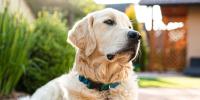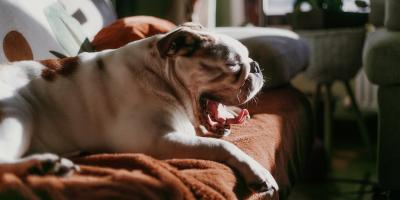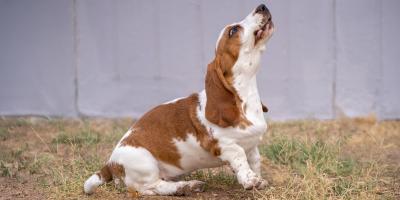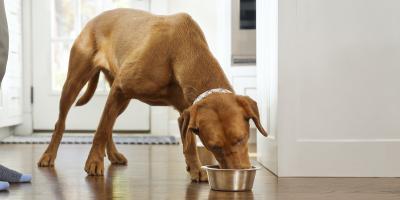How to Stop a Dog’s Aggressive Behavior


As a dog owner, one of the most important things to know is what to do if your dog shows signs of aggression. While an aggressive dog can be scary, the good news is that if you act immediately, steps can be taken to understand, reduce and potentially eliminate this behavior.
Aggressive Dog Behaviors
If your dog exhibits any of the following aggressive behaviors, call your veterinarian right away.
Aggressive dog behaviors can include:
- Signs of aggression toward strangers
- Aggression toward family members
- Guarding of resources, such as food, treats or toys
- Threatening behavior or fighting with other dogs in the household
- Threatening behavior or fighting with unknown dogs
Your veterinarian can assess whether there is a clinical reason for this behavior, such as pain, discomfort or another physical cause.
If there’s no apparent medical explanation, ask your veterinarian to refer you to a professional behaviorist. Check your pet insurance policy, as visits to pet behaviorists may be covered.
No matter how well you know your dog, do not attempt to treat your dog’s aggression yourself. Prompt professional intervention can keep your dog’s behavior from escalating and prevent harm to yourself, your family, other people and animals.
Why is My Dog Aggressive?
This question requires an examination by your veterinarian or an assessment by a qualified behaviorist. They can identify your dog’s triggers and explain what next steps are in addressing the aggressive behavior.
How to Manage Aggression
Leash Aggression
If your dog shows aggression toward people or other dogs while out on walks, keep him on a leash and consider training your dog to wear a muzzle when you are outdoors or in public.
Dogs who are difficult to control while on a leash, should get their exercise and play in a fenced-in yard. Work on your reward-based training and give him lots of mental stimulation through enrichment activities and games. This will help work some energy off and improve your bond in a safe space until a behaviorist can help you.
Aggression Toward Visitors
If your dog is aggressive toward visitors to the home, put him in the yard or a secure room before opening the door or greeting guests. Some dogs only show aggression when people come into their perceived territory. So, be especially careful at doorways, gates and even car doors.
Aggression Toward Other Dogs
To prevent aggression toward other dogs, keep them separate until you can see a behaviorist for advice.
In the event of a fight breaking out between two dogs, don’t try to separate them with your hands – you could get a serious injury. Your safety should come first, so remember to keep a reasonable distance and avoid any possibility that your dog could redirect his aggression toward you.
Dog fights often sound and look worse than they are. In many cases, the dogs will separate without human intervention. If a fight breaks out, it’s important to react fast. First try to distract them by yelling or clapping your hands loudly. If this doesn’t work, try throwing water or a towel over them, or making an unexpected loud noise such as clanging metal pans. That brief second of startled surprise may allow one of the dogs to remove himself from the fight.
Fear Aggression in Dogs
Most aggressive behavior in dogs is from fear and is intended as an act of self-defense. It’s an attempt to stop the things he finds frightening or unpleasant, make them go away or prevent them from happening in the first place.
Inadequate early puppy socialization, past experiences or the perception that valuable resources – such as food – are at risk of being taken away can all cause fear in a dog. Some dogs who have been roughly handled as a puppy can also grow up to be more reactive as adults.
Since fear is the most common cause of aggressive behavior in dogs, you should never punish your dog for growling or any other display of aggression. Shouting at a dog for growling at something he fears can compound his fear, cause confusion and could cause a more aggressive response next time. Also, by shouting at your dog, you may be inadvertently training them not to communicate their fear early, and they may go straight to biting when they are in a similar situation in the future.
Dog Aggression Warning Signs
Dog aggression warning signs can include:
- Yawning or licking lips: This is often the first indicator that your dog feels uncomfortable.
- Head turn: Along with yawning or licking lips, he may turn his head away from the cause of his discomfort.
- Whale eye: Often, aggressive dog behavior will include a dog showing the whites of his eyes, commonly known as “whale eye.”
- Crouching with his tail between his legs: More obvious warning signs include crouching with his tail between his legs, lifting his paw or tensing around the eyes or mouth.
- Stillness: Sometimes, a dog will become stiff or still before he becomes aggressive.
- A wagging tail: A wagging tail isn’t always indicative of a friendly dog. A stiff wagging tail or a tail wag in a dog who is crouching with a lowered body language can all signal a conflicted, fearful or worried dog.
- Growling: This is often the last warning – yet for many people, this is the first time they notice something is wrong. Growling is a clear expression of fear and discomfort. He will likely escalate to biting if the situation does not change. If your dog feels punished for growling, he may fail to give you that final warning and instead escalate straight to the next level – biting.
What Should I Do if My Dog is Aggressive?
Learn how to recognize how your dog is feeling. Most dogs give warning signs before they bite or attack – especially the first time – but owners don’t always understand those signals.
How to Help an Agitated Dog
- Remove the source of your dog’s stress, fear or arousal or remove him from the situation.
- Take steps to prevent the situation from reoccurring. For example, if your dog shows signs of food aggression, feed him in a room by himself until you can seek professional advice.
- All dogs are different and have their own individual stressors. Watch your dog for cues on how he’s feeling. Most aggression happens because owners put their dogs in situations that make dogs uncomfortable.
- If aggression becomes a regular behavior or if you’re concerned that it might, or if you feel threatened by your dog in any way, seek professional help immediately.
- If your dog shows any of the behaviors detailed above around children, immediately separate them and avoid all encounters with children while seeking a referral to a dog behaviorist. The same goes for any other people in the family or anyone you encounter. Never take chances with people’s safety or the safety of your dog.
- Seek professional advice sooner rather than later for all cases of aggression.
Get more information on dog behavior from our experts on our Pet Expertise page.
Related articles

Reward Yourself with myPurina
Earn and redeem rewards for Purina products with the myPurina app.





